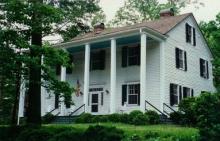Clermont State Historic Site

Clermont became the home of the historic Livingston family in 1728 when Robert Livingston, Jr. inherited 13,000 acres along the Hudson River. The property has morphed over time with later generations making improvements and adding land through marriage. Most famous of the Livingstons may be Robert R. Livingston, Jr. A member of the Committee of Five responsible for drafting the Declaration of Independence, he also served as the first United States Minister of Foreign Affairs (Secretary of State) and, as Chancellor of the State of New York, he gave the oath of office to George Washington as first President of the United States.
Because of the Livingston family's prominent role in support of independence, Clermont was burned by British troops under the command of General John Vaughan during a foray up the Hudson River in the autumn of 1777. Margaret Beekman Livingston, who managed the estate during most of the war years, rebuilt the family home between 1779 and 1782. After America won its independence, Chancellor Livingston began developing Clermont as an agriculture showplace. His experiments with sheep breeding and methods for increasing the yield of crops, while retaining the fertility of the soil, received national attention. In 1792 the Chancellor began construction of an elaborate new mansion just south of the original house as the centerpiece of his experimental farm. Built in the shape of a capital "H," this house was also called Clermont. It was destroyed by fire in 1909, but its ruins are still visible and indicate its size and grandeur.
Chancellor Livingston concluded his public career as Thomas Jefferson's Minister to France between 1801 and 1804. While in Paris, he negotiated the Louisiana Purchase and entered into a partnership with Robert Fulton a Pennsylvania-born painter and inventor who shared Livingston's fascination with steam navigation. Their creation, which they called the “North River” is more popularly called the Clermont Their steamboat. It embarked on its maiden voyage between New York City and Albany in 1807, setting off a transportation revolution in the United States.
Chancellor Livingston died at his Clermont estate in 1813. The original Clermont residence which had remained the home of Margaret Beekman Livingston until her death in 1800, was willed to the Chancellor's eldest daughter. The Chancellor's heirs initiated a series of additions and alterations to the house during the nineteenth century. The last significant changes to the old Clermont residence were made in the 1920s when John Henry Livingston and his wife, Alice Delafield Clarkson Livingston, remodeled the home in a Colonial Revival style. After Mr. Livingston's death, Alice Livingston continued to reside in the house until the onset of the Second World War, when she relocated to the nearby gardener's cottage. Thereafter, the mansion was only opened for special occasions during the summer months. In 1962 Mrs. Livingston deeded most of her family's historic estate to the State of New York.






























